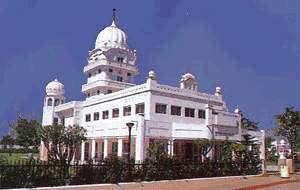Gurudwara Manji Sahib (Alamgir)
Gurudwara Manji Sahib in Ludhiana District's Alamgir village reflects yet another landmark in the life of the 10th Sikh Guru, Guru Gobind Singh. The Guru was pursued by the Mughal Army and it was at this Gurudwara that he paused and rested, and blessed it with his presence.
History
During Guru Gobind Singh's time, the Mughals under Emperor Aurangzeb were regaining their ascendancy, and the former realised that it was his task to right the wrong.
Following the battle in Anandpur Sahib, the Guru abandoned the fort and came to Macchiwara, where his family was put to death. It was then that two Pathan brothers, Ghani Khan and Nabi Khan, even at the prospect of facing certain death, helped the Guru to escape from the Mughal army. Guru Gobind Singh donned the blue robes of a Muslim saint and accompanied by three Sikhs, all survivors of the Battle of Chamkaur, was carried in a palanquin through enemy lines. He discarded his disguise at Alamgir and took a horse which was presented to him by Bhai Naudha, a resident of Alamgir.
The place where the Guru stayed was where the Gurudwara Manji Sahib was constructed. On reaching Alamgir and unable to find any drinking water, the Guru ordered his followers to fetch drinking water from a nearby well. But they could not, as the boundary wall had fallen into well and the water was contaminated. The Guru then shot an arrow into the ground and a spring of water gushed out.
"Villagers told Guruji that water of the well had become contaminated as the nearby wall had falled into it. The guru, while sitting shot an arrow into the ground where appeared a spring of drinking water. This spring has been converted into a tank known as `Tirsar', or Arrow Lake. The Guru said that whoever visits the holy tank with full faith, all his pains and worries would be cured,"
Due to the Manji or palanquin that brought the disguised Guru to Alamgir, the Peer of Ucch bestowed this Gurudwara its name, the Manji Sahib. That original rare artifact, the palanquin has been preserved here, in an underground cell, to this day. For devotees, the Gurudwara Manji Sahib is a pilgrimage as well as a tourist destination, both for its sanctity and the slice of Sikh history that it offers. It is one of the many shrines of the Sikhs, contributing its bit to the glorification of Sikhism.
The langar or community meal at the Gurudwara Manji Sahib is said to be one of the biggest among all Sikh religious shrines, catering to hundreds of people free of cost every day in the spirit of service to mankind. Generations on, Gurudwara Manji Sahib is in itself a picture of Sikhism in its ideal glory.
References
- http://in.news.yahoo.com/061219/139/6afg2.html
- Kingi Singh, Granthi, Gurudwara Manji Sahib, Alamgir

